Masalah Rambut Botak dan Penyelesaian: Transplantasi Rambut

Apa itu Masalah Rambut Botak? Masalah rambut botak adalah isu yang semakin banyak dihadapi oleh ramai individu di seluruh dunia. Sama ada disebabkan oleh faktor genetik, hormon, atau gaya hidup. Kehilangan rambut boleh memberi impak besar terhadap keyakinan diri dan penampilan seseorang. Dalam menghadapi masalah ini, salah satu penyelesaian yang semakin popular dan berkesan adalah tanam rambut. Artikel ini akan mengupas tentang masalah rambut botak dan bagaimana tanam rambut boleh menjadi jawapan kepada masalah tersebut. Punca-Punca Rambut Botak Keturunan (Genetik): Androgenetic alopecia adalah punca utama rambut botak, terutamanya di kalangan lelaki. Ini berlaku apabila hormon androgen merosakkan folikel rambut dan menyebabkan rambut menjadi semakin nipis dan akhirnya gugur. Hormon yang tidak seimbang: Ketidakseimbangan hormon iaitu masalah tiroid dan perubahan hormon semasa kehamilan atau menopaus boleh menyebabkan keguguran rambut. Tekanan dan Stres: Tekanan emosi dan stres berlebihan boleh menyebabkan keadaan yang dikenali sebagai Telogen effluvium, di mana rambut gugur secara mendadak. Penyakit dan Jangkitan: Beberapa penyakit autoimun seperti alopecia areata atau jangkitan kulat pada kulit kepala boleh menyebabkan akan kehilangan rambut. Pemakanan yang Tidak Seimbang: Kekurangan nutrien penting dalam diet boleh mempengaruhi kesihatan rambut dan menyebabkan keguguran. Apa Itu Penanaman Rambut? Penanaman rambut adalah prosedur pembedahan di mana folikel rambut diambil dari kawasan yang masih mempunyai rambut yang tebal (biasanya dari belakang kepala) dan dipindahkan ke kawasan yang botak atau kurang rambut. Tujuannya adalah untuk mengembalikan pertumbuhan rambut di kawasan yang terjejas dan memperbaiki penampilan keseluruhan. Prosedur Penanaman Rambut Penilaian Awal: Sebelum prosedur, doktor akan menilai keadaan rambut dan kulit kepala anda untuk menentukan jenis dan tahap keguguran rambut. Ini termasuk berbincang tentang matlamat dan jangkaan anda. Persediaan: Pada hari prosedur, kawasan penderma dan kawasan penerima akan disediakan. Biasanya, anestesia tempatan digunakan untuk memastikan bahawa anda tidak merasa sakit semasa prosedur. Pengambilan Folikel Rambut: Terdapat dua teknik utama untuk pengambilan folikel rambut: FUT (Follicular Unit Transplantation): Sebuah jalur kulit dari kawasan penderma diambil dan dipotong menjadi unit folikel rambut yang kecil. FUE (Follicular Unit Extraction): Folikel rambut diambil satu per satu dari kawasan pemderma menggunakan jarum kecil. Penanaman Folikel Rambut: Folikel rambut yang telah diambil akan ditanamkan ke dalam kawasan botak atau kurang rambut dengan teliti. Proses ini memerlukan kepakaran untuk memastikan hasil yang semulajadi. Pemulihan: Selepas prosedur, kawasan yang dipindahkan akan mengalami sedikit bengkak dan kemerahan. Doktor akan memberikan arahan penjagaan pasca-prosedur untuk memastikan pemulihan yang baik dan hasil yang optimum. View this post on Instagram A post shared by GLOJAS HAIR TRANSPLANT SPECIALIST MALAYSIA (@fuehairtransplantmalaysia) Kelebihan Tanam Rambut Hasil Semulajadi: Dengan teknik dan pengalaman yang betul, tanam rambut boleh menghasilkan penampilan yang semulajadi dan tahan lama. Hasil yang Kekal: Rambut yang ditanam akan berkembang seperti rambut asli dan tidak terjejas oleh masalah botak di masa depan. Penyelesaian Jangka Panjang: Berbanding dengan rawatan non-pembedahan yang memerlukan penggunaan produk secara berterusan, penanaman rambut memberikan penyelesaian yang lebih kekal. Peningkatan Keyakinan Diri: Memulihkan rambut boleh memberikan dorongan besar kepada keyakinan diri dan imej peribadi seseorang. Risiko dan Kesan Sampingan Walaupun penanaman rambut adalah prosedur yang selamat, namun terdapat beberapa risiko dan kesan sampingan yang perlu dipertimbangkan: Kemerahan: Kawasan yang dirawat mungkin mengalami kemerahan dan bengkak, tetapi ini biasanya bersifat sementara. Jangkitan: Risiko jangkitan boleh berlaku walaupun jarang, dan memerlukan penjagaan yang teliti. Hasil Tidak Memuaskan: Dalam sesetengah kes, hasil mungkin tidak memenuhi jangkaan, dan mungkin memerlukan prosedur tambahan. Kesimpulan Rambut botak adalah masalah yang boleh memberi kesan mendalam kepada keyakinan diri dan penampilan seseorang. Penanaman rambut merupakan penyelesaian yang berkesan dan kekal untuk mengatasi masalah ini. Dengan prosedur yang betul dan penjagaan yang rapi, anda boleh mendapatkan semula rambut yang penuh dan sihat, dan menikmati perubahan positif dalam penampilan serta keyakinan diri anda. Jika anda mempertimbangkan penanaman rambut, pastikan anda mendapatkan nasihat daripada pakar untuk menentukan sama ada prosedur ini adalah pilihan yang sesuai untuk anda. Di Glojas, kami sentiasa bersedia untuk memberikan servis yang terbaik dan membantu anda untuk menyelesaikan masalah rambut botak ini. Dengan pengalaman yang lebih dari 26 tahun, pakar kami akan memberikan yang terbaik sehingga anda berpuas hari dengan keputusan selepas prosuder berjalan. BACA ARTIKEL : Proses Tanam Rambut | Prosedur dan Proses yang Perlu Diketahui Facebook Twitter LinkedIn Reddit Pinterest WhatsApp
Proses Tanam Rambut | Prosedur dan Proses yang Perlu Diketahui
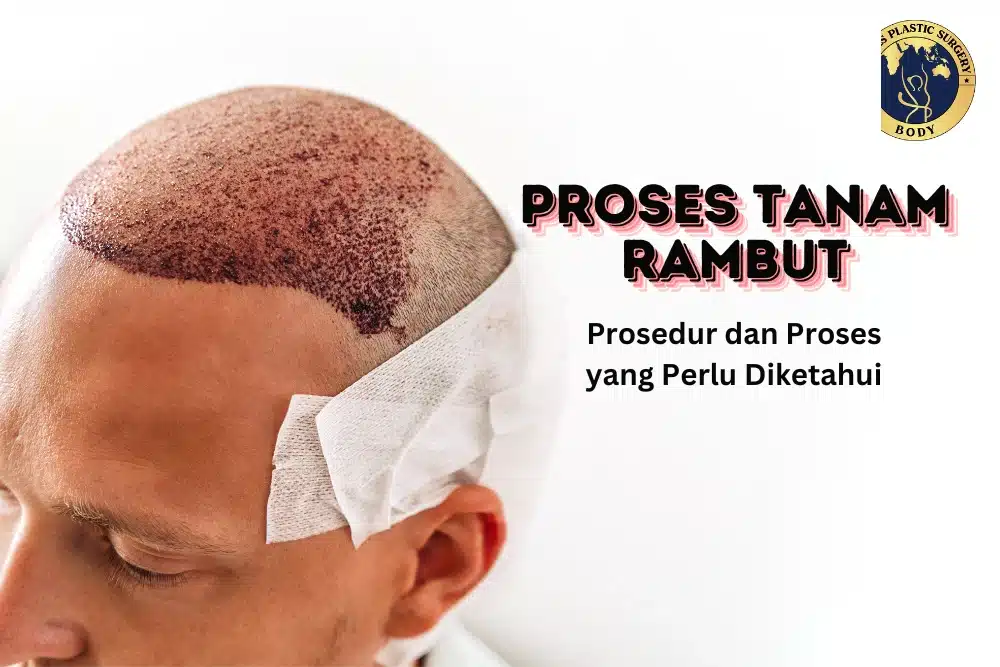
Tanam Rambut telah menjadi salah satu kaedah popular bagi mereka yang mengalami masalah kebotakan atau penipisan rambut yang ketara. Kaedah ini melibatkan pindahan rambut dari kawasan yang lebih padat kepada kawasan yang jarang atau botak, memberi penampilan yang semula jadi dan berdaya tahan. Free Consultation Here : https://glojasaesthetic.com/hair-services/hair-transplant/ Bagaimana Proses Tanam Rambut Dilakukan? Konsultasi Awal: Prosedur ini bermula dengan konsultasi bersama pakar tanam rambut untuk menentukan keadaan kulit kepala dan keseimbangan rambut yang diperlukan. Penilaian: Doktor akan menilai kawasan yang memerlukan tanam rambut dan menentukan kaedah terbaik untuk mencapai hasil yang optimal. Pemilihan Rambut: Rambut yang akan digunakan untuk pindahan boleh diambil dari rambut sendiri . Proses Pindahan: Rambut yang dipilih dipindahkan ke kawasan yang diinginkan menggunakan teknik yang teliti dan cermat. Pasca-Prosedur: Selepas prosedur, perawatan lanjutan diberikan untuk memastikan pemulihan yang sempurna dan hasil yang memuaskan. View this post on Instagram A post shared by GLOJAS AESTHETIC SPECIALIST (@glojasaesthetic) Kelebihan Tanam Rambut Keberkesanan: Memberikan hasil semula jadi dengan penampilan yang penuh dan padat. Kepercayaan Diri: Meningkatkan kepercayaan diri individu yang mengalami masalah kebotakan. Kaedah Selamat: Kaedah ini merupakan prosedur yang selamat dengan risiko kegagalan yang rendah. Keselamatan: Dengan teknologi moden, prosedur ini biasanya tidak melibatkan risiko kesan sampingan yang serius. Tanam Rambut merupakan pilihan terbaik bagi individu yang ingin mengatasi masalah kebotakan atau penipisan rambut dengan cara yang berkesan dan selamat. Walau bagaimanapun, sebelum membuat keputusan, penting untuk berunding dengan pakar kesihatan untuk memastikan prosedur ini sesuai dengan keperluan dan kesihatan anda. Dengan adanya maklumat yang tepat, anda boleh membuat keputusan yang bijak bagi kebaikan jangka panjang kesihatan dan kecantikan rambut anda. BACA ARTIKEL : Tanam Rambut Facebook Twitter LinkedIn Reddit Pinterest WhatsApp
Punca Rambut Kelemumur | Rawat Kelemumur Dengan Ketahui Punca Utama
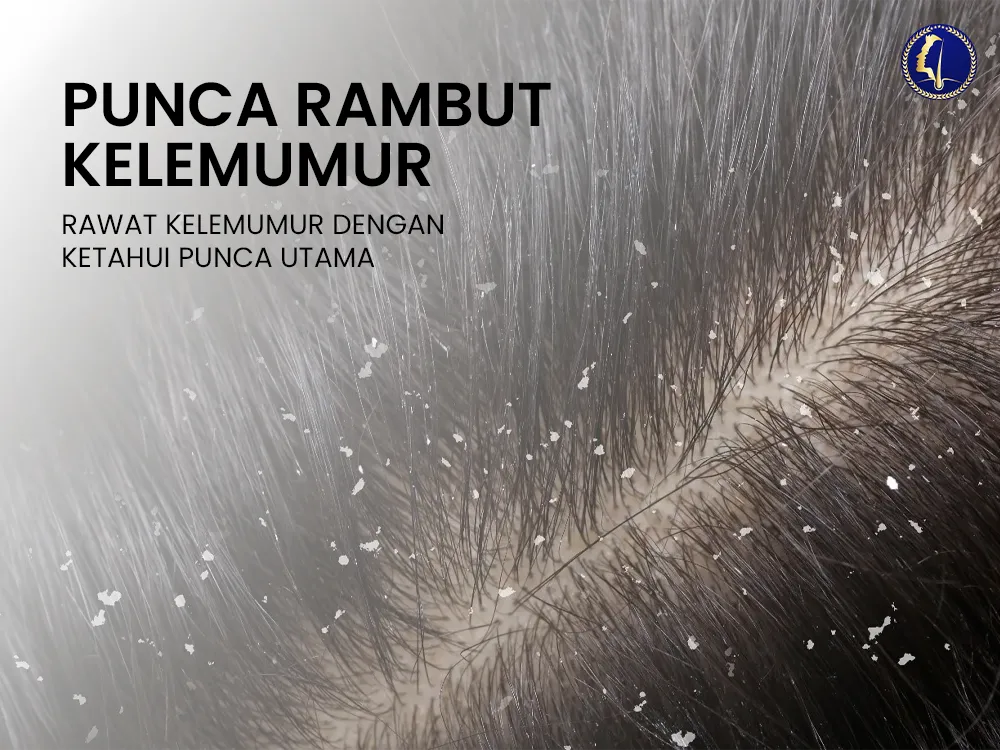
Mengatasi Masalah Kelemumur dengan Punca Utama Punca Rambut Kelemumur – Kelemumur merupakan salah satu masalah rambut yang sering dialami oleh ramai individu di seluruh dunia. Ia tidak hanya menyebabkan rasa tidak selesa di kulit kepala tetapi juga boleh mempengaruhi keyakinan diri seseorang. Bagi sesetengah individu, masalah kelemumur boleh menjadi ketara dan mengganggu kehidupan seharian mereka. Apa Itu Kelemumur? Kelemumur adalah masalah kulit kepala yang sering menyebabkan ketidakselesaan, ditandai dengan kulit kepala yang kering, bersisik, dan kadang-kadang gatal. Keadaan ini biasanya berpunca dari pelbagai faktor, antaranya kekurangan kelembapan pada kulit kepala, pertumbuhan sel kulit yang terlalu cepat, serta pengumpulan sel mati yang terkelupas dan membentuk serpihan putih. Kelemumur juga boleh berlaku disebabkan oleh: Dermatitis Seborrheic: Satu keadaan keradangan kulit yang menyebabkan kulit kepala menjadi merah, berminyak, dan berkelupas. Jangkitan Kulat: Kulit kepala yang dijangkiti kulat seperti Malassezia boleh mengganggu keseimbangan mikroorganisma dan menyebabkan kelemumur. Kulit Kepala Kering: Kekurangan pelembap pada kulit kepala boleh menyebabkan sel kulit mengelupas, terutamanya pada musim sejuk atau persekitaran yang kering. Penggunaan Produk Rambut yang Tidak Sesuai: Bahan kimia dalam produk penjagaan rambut seperti syampu, pewarna rambut, atau gel rambut boleh menyebabkan reaksi alergi dan iritasi, mengakibatkan gatal-gatal dan kelemumur. Stres dan Diet Tidak Seimbang: Faktor psikologi dan kekurangan nutrisi, terutama dalam pengambilan vitamin dan mineral yang penting untuk kesihatan kulit, boleh meningkatkan risiko kelemumur. Hormon dan Perubahan Musim: Perubahan hormon atau peralihan musim juga boleh memberi kesan kepada keseimbangan kulit kepala. Walaupun kelemumur tidak berbahaya, ia boleh menjejaskan penampilan dan menyebabkan rasa kurang selesa. Untuk merawatnya, penting untuk memilih syampu yang sesuai, menjaga kebersihan kulit kepala, serta menghindari produk yang boleh mengiritasi kulit kepala. Jika masalah berterusan, berjumpa dengan doktor atau pakar dermatologi adalah langkah yang disarankan. Berikut adalah beberapa punca kelemumur pada rambut Kulit Kepala Kering:Kurangnya kelembapan dalam kulit kepala boleh menyebabkan pengelupasan yang berlebihan. Kulit Kepala Berminyak:Penghasilan terlalu banyak minyak oleh kelenjar sebum boleh menyebabkan pertumbuhan kulat yang akan menyebabkan kelemumur. Pemakaian Produk Rambut yang Tidak Sesuai:Penggunaan produk rambut seperti syampu atau perapi rambut yang mengandungi bahan kimia tertentu boleh menyebabkan kelemumur. Kulit Sensitif atau Alergi:Reaksi alergi terhadap bahan-bahan tertentu dalam produk rambut atau kosmetik boleh mempengaruhi kulit kepala dan menyebabkan kelemumur. Kurangnya Pembersihan Rambut:Tidak mencuci rambut secara teratur atau dengan betul boleh menyebabkan petompokan kotoran dan minyak yang boleh menggalakkan pertumbuhan kulat. Stres dan Kehidupan yang Tidak Seimbang:Kondisi stres atau tekanan emosi yang berlebihan boleh menyebabkan ketidakseimbangan hormon yang boleh menyumbang kepada masalah kelemumur. Kulit Kepala yang Terlalu Sensitif Terhadap Cuaca:Perubahan cuaca yang drastik atau cuaca yang terlalu panas atau sejuk boleh memberi kesan negatif kepada kulit kepala dan menyebabkan kelemumur. Kurangnya Nutrien:Diet yang tidak seimbang atau kekurangan nutrien tertentu seperti vitamin B, zinc, atau lemak omega-3 boleh mempengaruhi kesihatan kulit kepala dan rambut. Rawatan Rambut Kelemumur di GLOJAS. Protokol Ubat SMART™SMART™ Medication Protocol telah dicipta oleh Profesor Dato’ Dr. JasG untuk membantu mereka yang mengalami keguguran rambut. Menggunakan formulanya sendiri, SMART™ Medication Protocol mampu menggalakkan pertumbuhan rambut baharu dan mengekalkan kulit kepala yang sihat. Peremajaan Rambut (Hair Rejuvenation)Peremajaan Rambut terdiri daripada PDT Light, Jet Peel dan Terapi Laser Tahap Rendah yang membantu menggalakkan pembaikan tisu dan pertumbuhan semula rambut. Antara kebaikan Peremajaan Rambut (Hair Rejuvenation) ialah untuk menguatkan folikel rambut yang lemah dengan berkesan dan juga merangsang pertumbuhan rambut yang lebih panjang dan padat. Kesimpulannya, Secara keseluruhan, kelemumur adalah masalah yang boleh mengganggu dan mempengaruhi kepercayaan diri seseorang. Dalam usaha untuk mengatasi masalah ini, penting untuk memahami punca-punca yang mungkin menyebabkan masalah rambut kelemumur, seperti kulit kepala kering, pengeluaran berlebihan minyak, penggunaan produk rambut yang tidak sesuai, dan faktor-faktor lain seperti kekurangan nutrien atau stres. Dengan penggunaan yang konsisten dan pemilihan produk yang sesuai, individu boleh mendapatkan kulit kepala yang lebih sihat dan bebas dari kelemumur, serta rambut yang tampak lebih baik dan lebih berkilau. Di Glojas Clinic, kami mempunyai Pakar Rambut yang telah berpengalaman lebih dari 26 tahun bersedia untuk membantu anda yang mengalami masalah rambut kelemumur. Dengan adanya testimoni yang baik dari pelanggan terdahulu kami, Glojas semestinya akan menyediakan perkhidmatan rawatan rambut yang sesuai kepada pesakit kami.
Rawatan Rambut Kelemumur | Kembalikan Keyakinan Dengan Rambut Bebas Kelemumur Di Glojas

Rawatan Rambut Kelemumur: Cara Mengatasi Masalah Kelemumur Secara Berkesan Kelemumur merupakan masalah umum yang dialami oleh ramai individu. Ia bukan sahaja menyebabkan rasa tidak selesa pada kulit kepala tetapi juga boleh mempengaruhi kepercayaan diri seseorang kerana rambut yang kelihatan tidak bersih dan kurang sihat. Bagi mereka yang menghadapi masalah kelemumur, rawatan yang berkesan adalah penting untuk mengatasi masalah ini. Alamat : Glomac Galeria Hartamas, B-G, 05, Jalan 26a/70a, Desa Sri Hartamas, 50480 Wilayah Persekutuan, Wilayah Persekutuan Kuala Lumpur Dapatkan Arah Telefon : 012-989 1915 Laman Social : Facebook Youtube Instagram Apa Itu Kelemumur? Kelemumur adalah keadaan di mana kulit kepala menghasilkan kulit mati yang kelihatan seperti serpihan putih kecil. Ia boleh disebabkan oleh pelbagai faktor termasuk kulit kepala yang berminyak, kulit kepala yang kering, kulit sensitif, atau reaksi terhadap produk rambut tertentu. Kelemumur juga boleh diperparah oleh stres, cuaca yang terlalu panas atau sejuk, serta kekurangan nutrisi dalam pemakanan. Mengapa Rawatan Kelemumur Penting? Kesihatan Kulit Kepala: Rawatan kelemumur yang berkesan dapat menyihatkan kulit kepala, mengurangkan gatal-gatal atau rasa tidak selesa yang berkaitan dengan kelemumur. Rambut Yang Lebih Bersih dan Sihat: Dengan menghilangkan kelemumur, rambut kelihatan lebih bersih, bersinar, dan lebih bermaya. Penjagaan Rambut Secara Keseluruhan: Rawatan kelemumur sering melibatkan penggunaan produk yang mengandungi bahan-bahan yang baik untuk kesihatan rambut secara keseluruhan, seperti pelembap untuk menjaga kelembapan rambut dan kulit kepala. Rawatan Rambut Kelemumur di GLOJAS. Protokol Ubat SMART™SMART™ Medication Protocol telah dicipta oleh Profesor Dato’ Dr. JasG untuk membantu mereka yang mengalami keguguran rambut. Menggunakan formulanya sendiri, SMART™ Medication Protocol mampu menggalakkan pertumbuhan rambut baharu dan mengekalkan kulit kepala yang sihat. Peremajaan Rambut (Hair Rejuvenation) Peremajaan Rambut terdiri daripada PDT Light, Jet Peel dan Terapi Laser Tahap Rendah yang membantu menggalakkan pembaikan tisu dan pertumbuhan semula rambut. Antara kebaikan Peremajaan Rambut (Hair Rejuvenation) ialah untuk menguatkan folikel rambut yang lemah dengan berkesan dan juga merangsang pertumbuhan rambut yang lebih panjang dan padat.https://www.youtube.com/watch?v=CA_qS8RwMos Pakar Tanam Rambut di GLOJAS View this post on Instagram A post shared by GLOJAS HAIR TRANSPLANT SPECIALIST MALAYSIA (@fuehairtransplantmalaysia) Rawatan kelemumur adalah langkah penting untuk memastikan kulit kepala dan rambut yang sihat dan bersih. Dengan memilih rawatan yang sesuai dan mengamalkan tips yang betul, masalah kelemumur dapat dikawal dengan berkesan. Ingatlah bahawa setiap individu mempunyai keperluan yang berbeza, oleh itu penting untuk mencari nasihat daripada pakar atau profesional kesihatan jika kelemumur menjadi masalah yang serius atau berterusan. Dengan usaha yang konsisten, rambut yang sihat dan bebas kelemumur bukanlah impian yang mustahil untuk dicapai. Dapatkan Konsultasi Percuma Sekarang! BACA ARTIKEL : Rawatan Rambut Gugur Lelaki Facebook Twitter LinkedIn Pinterest Reddit WhatsApp
Rawatan Rambut Botak | Solusi Terbaik untuk Rambut Botak di GLOJAS
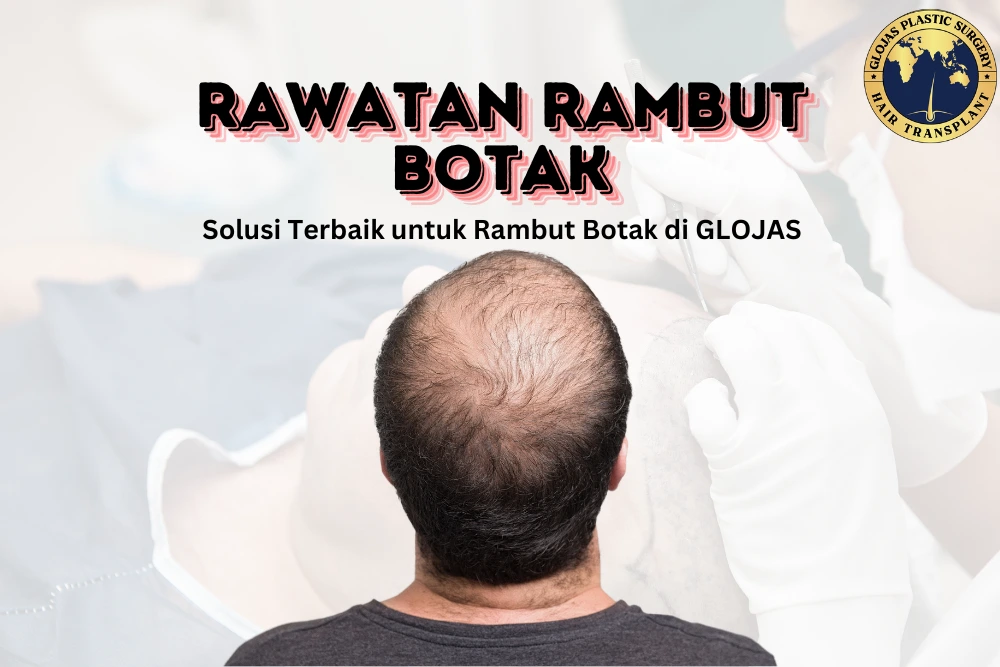
Rawatan Rambut Botak: Mengembalikan Keyakinan Diri Anda Masalah rambut botak bukanlah isu yang asing dalam masyarakat kita. Sama ada lelaki atau wanita, ramai yang berhadapan dengan masalah kehilangan rambut yang serius. Keguguran rambut boleh disebabkan oleh pelbagai faktor seperti genetik, tekanan, pemakanan yang tidak seimbang, dan penggunaan produk rambut yang mengandungi bahan kimia keras. Oleh itu, rawatan rambut botak menjadi pilihan utama untuk mengatasi masalah ini dan mengembalikan keyakinan diri. Alamat : Glomac Galeria Hartamas, B-G, 05, Jalan 26a/70a, Desa Sri Hartamas, 50480 Wilayah Persekutuan, Wilayah Persekutuan Kuala Lumpur Dapatkan Arah Telefon : 012-989 1915 Laman Social : Facebook Youtube Instagram Penyebab Rambut Gugur GenetikKebanyakan kes keguguran rambut pada lelaki adalah disebabkan oleh keadaan yang dikenali sebagai alopecia androgenetik, atau lebih dikenali sebagai kebotakan corak lelaki. Kondisi ini diwarisi dan dipengaruhi oleh hormon dihydrotestosterone (DHT). Perubahan HormonSelain genetik, perubahan hormon juga boleh menyumbang kepada keguguran rambut. Hormon seperti testosteron boleh bertukar menjadi DHT yang mempunyai kesan mengecutkan folikel rambut sehingga rambut menjadi lebih nipis dan akhirnya gugur. Faktor PemakananKekurangan zat makanan tertentu seperti protein, zat besi, dan vitamin B kompleks boleh menyebabkan rambut menjadi lemah dan mudah gugur. TekananStres, sama ada fizikal atau emosi, boleh menyebabkan rambut masuk ke dalam fasa rehat lebih awal dari biasa yang kemudiannya mengakibatkan keguguran rambut. Penjagaan Rambut yang Tidak SesuaiPenggunaan bahan kimia keras, peralatan pemanas, dan teknik penjagaan rambut yang kasar juga boleh merosakkan rambut dan menyebabkan keguguran. Rawatan Rambut Botak Pemindahan Rambut (Hair Transplant)Pemindahan rambut adalah salah satu rawatan yang popular dan efektif. Dalam prosedur ini, folikel rambut diambil dari bahagian tubuh yang mempunyai pertumbuhan rambut yang baik, seperti belakang kepala, dan dipindahkan ke bahagian yang botak. Teknik ini memerlukan masa pemulihan yang singkat dan hasilnya biasanya kekal. Ia sesuai untuk mereka yang mengalami keguguran rambut yang teruk. Rawatan PRP (Platelet-Rich Plasma)Rawatan PRP melibatkan penggunaan plasma yang kaya dengan platelet dari darah pesakit sendiri. Plasma ini disuntik ke kulit kepala untuk merangsang pertumbuhan rambut. PRP membantu memperbaiki folikel rambut yang rosak dan meningkatkan pertumbuhan rambut baru. Ia adalah pilihan yang selamat dan semulajadi, kerana ia menggunakan bahan dari tubuh sendiri. Terapi LaserTerapi laser adalah rawatan non-invasif yang menggunakan cahaya laser untuk merangsang pertumbuhan rambut. Cahaya laser membantu meningkatkan peredaran darah ke folikel rambut dan memperbaiki kualiti rambut yang tumbuh. Rawatan ini sesuai untuk mereka yang mengalami keguguran rambut yang ringan hingga sederhana. Ubat-ubatanTerdapat beberapa jenis ubat yang telah diluluskan oleh pihak berkuasa kesihatan untuk merawat keguguran rambut. Ubat seperti Minoxidil dan Finasteride sering digunakan untuk mengurangkan keguguran rambut dan merangsang pertumbuhan rambut baru. Minoxidil digunakan secara topikal, sementara Finasteride diambil secara oral. Penting untuk mendapatkan nasihat doktor sebelum memulakan rawatan ini. Penjagaan Rambut Secara SemulajadiSelain rawatan medikal, menjaga kesihatan rambut melalui cara semulajadi juga penting. Mengamalkan diet yang seimbang, kaya dengan vitamin dan mineral, dapat membantu menguatkan rambut. Vitamin seperti Biotin, Zinc, dan Vitamin E adalah baik untuk kesihatan rambut. Penggunaan minyak kelapa, minyak zaitun, dan lidah buaya sebagai rawatan rambut semulajadi juga boleh membantu mengurangkan keguguran rambut. Kaunseling dan Sokongan PsikologiMasalah keguguran rambut boleh memberi impak yang besar kepada keyakinan diri dan kesejahteraan mental seseorang. Oleh itu, kaunseling dan sokongan psikologi adalah penting untuk membantu individu mengatasi tekanan dan kecemasan yang berkaitan dengan masalah rambut botak. Mempunyai sistem sokongan yang baik dari keluarga dan rakan-rakan juga dapat membantu dalam proses pemulihan. https://www.youtube.com/watch?v=CA_qS8RwMos Pakar Tanam Rambut di GLOJAS View this post on Instagram A post shared by GLOJAS HAIR TRANSPLANT SPECIALIST MALAYSIA (@fuehairtransplantmalaysia) Masalah rambut botak tidak lagi perlu menjadi punca kehilangan keyakinan diri. Dengan pelbagai pilihan rawatan yang ada, setiap individu boleh mencari penyelesaian yang sesuai dengan keperluan dan keadaan mereka. Adalah penting untuk mendapatkan nasihat daripada pakar sebelum memulakan sebarang rawatan bagi memastikan ia selamat dan berkesan. Dengan usaha dan penjagaan yang betul, rambut lebat dan sihat bukan lagi impian yang sukar dicapai. Dapatkan Konsultasi Percuma Sekarang! BACA ARTIKEL : Rawatan Rambut Gugur Lelaki Facebook Twitter LinkedIn Pinterest Reddit WhatsApp Konklusi Akhir Alopecia areata adalah salah satu penyakit autoimun yang boleh menyebabkan kehilangan rambut secara tiba-tiba, bukan sahaja pada kulit kepala tetapi juga pada bulu mata dan rambut badan. Faktor seperti faktor genetik, kekurangan zat termasuk zat besi, atau masalah kesihatan lain turut menyumbang kepada masalah rambut seperti penipisan rambut, mengalami kebotakan, atau mengalami keguguran rambut. Perubahan pada garis rambut, kelemahan folikel rambut, dan gangguan dalam pertumbuhan rambut boleh menjadikan rambut menjadi nipis dan sukar membentuk rambut baru, sehingga seseorang lebih cenderung untuk mengalami masalah jangka panjang jika tidak ditangani awal.
Hair Transplant Hidden Technique: The Ultimate Guide
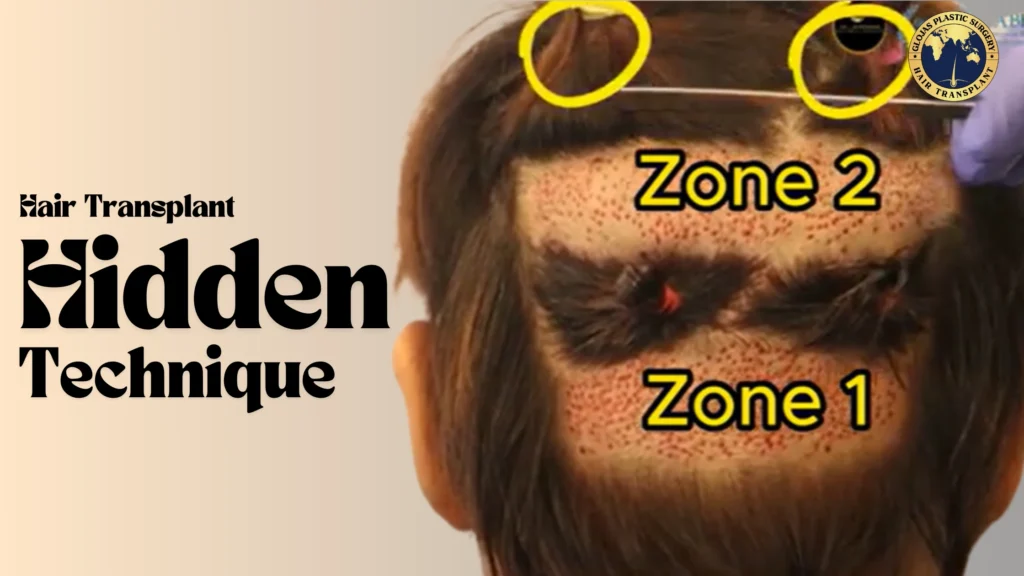
Introduction Are you dreaming of a full head of hair but worried about the visible scars that come with traditional hair transplant surgeries? You’re not alone. Many are turning to a lesser-known but highly effective technique known as the “hidden donor technique.” This innovative approach minimizes scarring and maximizes the natural-looking results of hair restoration. In this blog, we delve deeper into how this hidden technique works and why it might be the best option for restoring your hair with confidence. FUE Hair Transplant Follicular Unit Extraction (FUE) is a type of hair transplant done by harvesting individual hair follicles from your skin and implanting them in another part of your body where the hair’s thinner or absent. This method is highly favored for its precision and natural results. Procedure The FUE procedure begins with the surgeon administering local anesthesia to numb the donor area, ensuring comfort throughout the process. Next, using a micro hollow needle, the surgeon delicately extracts each follicular unit (typically containing 1 to 4 hairs). These grafts are preserved in a special solution to maintain their viability before they are implanted into the target area. The implantation process involves making tiny incisions in the scalp to place the follicular units according to the hair’s natural growth direction, which helps achieve a more natural look. Post-procedure, patients can expect minimal downtime and are usually able to return to their routine within a couple of days. Hair Transplant Hidden Technique A revolutionary advancement in the field of hair restoration is the Hidden Donor Technique, a subset of FUE. This method significantly enhances aesthetic outcomes by minimizing visible scarring and allowing for faster recovery. How It Here Works? The Hidden Donor Technique involves extracting hair follicles from areas that are not usually exposed or those covered by existing hair. Typically, these areas are at the back of the head or behind the ears. The main goal is to utilize parts of the donor area that can still be covered by hair if needed, avoiding any noticeable thinning. Through microscopic instruments and skilled precision, surgeons are able to access these hidden areas without shaving them, ensuring the extraction sites remain covered. Benefits The Hidden Donor Technique offers several compelling advantages: Reduced visibility of the extraction sites: Since the donor areas are selected from parts of the scalp that can be naturally concealed, post-surgical scarring is hardly noticeable. Preservation of hairstyle: There’s no need to shave off large sections of hair, so patients can maintain their current hairstyle, which makes this technique highly appealing for those in the public eye or constantly interacting with peers. Enhanced comfort and quicker recovery: With fewer visible signs of surgery, patients often feel more comfortable and regain confidence quickly. This technique also tends to facilitate a faster healing process due to the limited affected area. Unshaven Hair Transplant An Unshaven Hair Transplant, often referred to as U-FUE (Unshaven Follicular Unit Extraction), is a variation of the traditional FUE technique and aligns closely with the principles of the Hidden Donor Technique. During an U-FUE procedure, the hair is left at its natural length, and only the donor follicles are trimmed for extraction. This method provides discretion during the healing process, as the uncut surrounding hair conceals the treated areas. Benefits of the Unshaven Hair Transplant include: Discretion: The main advantage is that it doesn’t reveal that a hair transplant surgery has occurred. No drastic change in appearance: Patients continue to look the same before and after the procedure, which alleviates any potential anxiety associated with visible post-surgery changes. Ideal for minor enhancements: It’s perfect for patients requiring minor touch-ups or those who prefer maintaining a longer hairstyle. Both the Hidden Donor and Unshaven Hair Transplant techniques represent significant leaps forward in hair restoration technology, offering patients effective solutions with minimal social downtime and maximum confidentiality. Visibility of Hair Transplant Scars Hair transplant surgery has evolved significantly over the years, but one concern remains constant: the visibility of scars. Traditional hair transplantation techniques, particularly the Follicular Unit Transplantation (FUT) method, often result in a linear scar on the back of the head. This is where a strip of scalp skin containing hair follicles is removed, leaving behind a noticeable mark once healed. Are hair transplant scars visible? The visibility of hair transplant scars largely depends on the skill of the surgeon, the method used, and how well the patient’s skin heals. In general, the FUT technique can leave a more prominent linear scar that can be visible if the hair is worn very short. On the other hand, Follicular Unit Extraction (FUE), a newer technique, typically results in less noticeable scarring. In FUE, each follicular unit is individually extracted, leaving only tiny, round scars that are less visible and can be more easily concealed under existing hair, even if it’s cut quite short. FUT vs. FUE Hair Transplants Surgery: Pros and Cons Choosing the right hair transplant technique can drastically affect the outcome and satisfaction with the final results. Both FUT and FUE have unique advantages and drawbacks that a potential candidate needs to consider. What is the difference between FUT and FUE hair transplants? The main difference between Follicular Unit Transplantation (FUT) and Follicular Unit Extraction (FUE) lies in the method of extracting hair follicles. FUT involves removing a strip of tissue from the donor area at the back of the head, and then hair follicles are extracted from this strip. Conversely, FUE involves the direct extraction of individual hair follicles from the scalp without removing a strip of tissue. Pros and cons of FUT hair transplant Pros: Higher Yield: Generally, FUT allows for the transplantation of a higher number of grafts in a single session. Cost-Effective: FUT typically costs less than FUE as it is less labor-intensive and faster. Well-Established: As an older method, FUT has a long track record of satisfactory results. Cons: Scarring: Leaves a linear scar at the donor site, which can be visible with short hairstyles. Longer Recovery: The healing
Rawatan Rambut | Dapatkan Rawatan di GLOJAS

Rawatan Rambut: Panduan Penjagaan dan Kesihatan Rambut Rambut merupakan salah satu aset penting dalam penampilan seseorang. Penjagaan rambut yang baik bukan sahaja memastikan rambut kelihatan cantik dan terurus, tetapi juga menjamin kesihatan kulit kepala dan mencegah masalah-masalah rambut yang biasa. Berikut adalah beberapa panduan dan tips untuk rawatan rambut yang boleh diamalkan oleh semua peringkat umur. Alamat : Glomac Galeria Hartamas, B-G, 05, Jalan 26a/70a, Desa Sri Hartamas, 50480 Wilayah Persekutuan, Wilayah Persekutuan Kuala Lumpur Dapatkan Arah Telefon : 012-989 1915 Laman Social : Facebook Youtube Instagram Rawatan Rambut Memilih Syampu dan Perapi yang SesuaiPemilihan syampu dan perapi yang sesuai dengan jenis rambut adalah langkah pertama dalam penjagaan rambut. Terdapat pelbagai jenis syampu dan perapi di pasaran, yang masing-masing disesuaikan untuk jenis rambut yang berbeza seperti rambut kering, berminyak, atau rambut yang telah diwarnakan. Pastikan anda membaca label produk dan memilih yang paling sesuai dengan keperluan rambut anda. Kekerapan Mencuci RambutMencuci rambut dengan kerap adalah penting untuk menjaga kebersihan rambut dan kulit kepala. Walau bagaimanapun, mencuci rambut terlalu kerap boleh menghilangkan minyak semula jadi yang diperlukan untuk menjaga kelembapan rambut. Disarankan untuk mencuci rambut dua hingga tiga kali seminggu, bergantung kepada jenis dan keadaan rambut. Menggunakan Minyak RambutPenggunaan minyak rambut boleh membantu menjaga kelembapan rambut dan mengurangkan kekeringan. Minyak kelapa, minyak zaitun, dan minyak argan adalah antara pilihan yang popular. Minyak rambut boleh digunakan sebagai rawatan pra-syampu atau sebagai pelembap selepas mencuci rambut. Pemakanan yang SeimbangKesihatan rambut juga bergantung kepada pemakanan yang seimbang. Protein, vitamin, dan mineral seperti zink, zat besi, dan vitamin A dan E adalah penting untuk pertumbuhan dan kekuatan rambut. Pastikan diet anda mengandungi makanan yang kaya dengan nutrien-nutrien ini seperti daging tanpa lemak, kacang, sayur-sayuran hijau, dan buah-buahan. Mengurangkan Penggunaan Alat PemanasAlat pemanas seperti pengering rambut, alat pelurus, dan pengeriting rambut boleh merosakkan rambut jika digunakan secara berlebihan. Panas yang tinggi boleh menyebabkan rambut menjadi kering dan rapuh. Jika perlu menggunakan alat-alat ini, pastikan untuk menggunakan pelindung haba dan memilih setting suhu yang paling rendah. Rawatan SemulajadiTerdapat pelbagai rawatan semulajadi yang boleh membantu menjaga kesihatan rambut. Masker rambut yang diperbuat daripada bahan semulajadi seperti madu, telur, dan yogurt boleh memberikan nutrisi tambahan kepada rambut. Penggunaan bahan-bahan semulajadi ini secara berkala boleh membantu menguatkan rambut dan menambah kilauan. Urutan Kulit KepalaUrutan kulit kepala boleh meningkatkan peredaran darah dan merangsang folikel rambut. Luangkan masa beberapa minit setiap hari untuk mengurut kulit kepala dengan lembut menggunakan hujung jari. Ini bukan sahaja dapat mengurangkan tekanan tetapi juga membantu dalam pertumbuhan rambut yang sihat. Mengelakkan TekananTekanan adalah salah satu punca utama masalah rambut seperti keguguran rambut. Mengamalkan gaya hidup yang sihat dan teknik pengurusan tekanan seperti senaman, meditasi, dan tidur yang cukup dapat membantu menjaga kesihatan rambut. https://www.youtube.com/watch?v=besyQvqrdJ4 Pakar Tanam Rambut di GLOJAS View this post on Instagram A post shared by GLOJAS HAIR TRANSPLANT SPECIALIST MALAYSIA (@fuehairtransplantmalaysia) Penjagaan rambut yang baik memerlukan komitmen dan kesabaran. Dengan mengamalkan tips-tips ini, anda boleh memastikan rambut anda kekal sihat, cantik, dan bersinar sepanjang masa. Jangan lupa untuk sentiasa mendengar keperluan rambut anda dan menyesuaikan rutin penjagaan rambut mengikut perubahan keadaan rambut dan persekitaran. https://glojasaesthetic.com/hair-services/hair-transplant/ Dapatkan Konsultasi Percuma Sekarang! BACA ARTIKEL : Melebatkan Rambut Facebook Twitter LinkedIn Pinterest Reddit WhatsApp
Hair Graft 101: A Comprehensive Guide to Hair Restoration
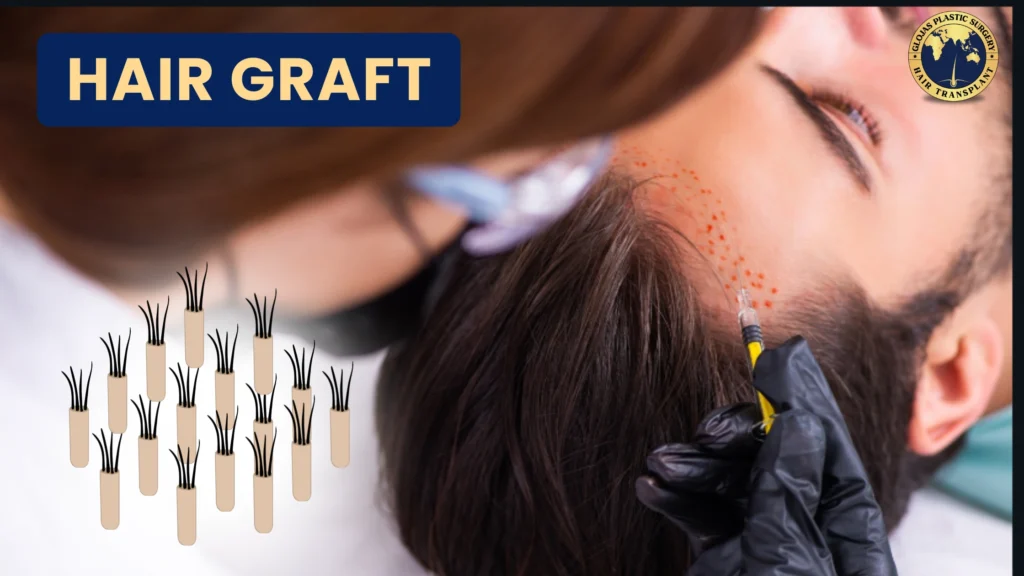
Dealing with Hair Loss? Hair loss can be a distressing condition, affecting not just your scalp but also your confidence and self-image. It commonly results from genetics, hormonal changes, medical conditions, or the natural aging process. While losing 50 to 100 hairs a day is normal, more significant loss can signal an issue. Fortunately, advances in medical technology have brought forth several effective treatments to combat hair loss, offering hope and solutions to those affected. Understanding Hair Graft Define hair graft and its significance in hair growth. A hair graft is a small piece of skin tissue containing hair follicles that is transplanted from a donor area of the scalp to a balding or thinning area. The primary goal of a hair graft is to restore growth in areas of the scalp affected by hair loss, such as in cases of male pattern baldness or other forms of alopecia. These grafts, once successfully transplanted, continue to produce hair in the new location in a natural growth pattern. This helps to create a fuller, more uniform look, significantly improving the aesthetic appearance and boosting the individual’s confidence. Explain the different types of hair graft procedures, including follicular unit extraction (FUE) and follicular unit transplantation (FUT). FUE FUT Hair transplant procedures primarily consist of two types: Follicular Unit Extraction (FUE) and Follicular Unit Transplantation (FUT). Follicular Unit Extraction (FUE): In FUE, each hair follicle is individually removed from the donor area using a small punch tool. This method is favored for its ability to heal faster and with less visible scarring, allowing the patient to return to normal activities sooner. FUE is particularly advantageous for individuals who prefer shorter hair styles or those who wish to avoid a linear scar. Follicular Unit Transplantation (FUT): FUT involves removing a strip of skin from the donor area and then dissecting it into individual follicular units. These units are then transplanted to the balding areas. While FUT generally leaves a linear scar, it allows for a higher volume of grafts to be transplanted in a single session and is typically recommended for patients requiring extensive coverage. Both techniques are highly effective and differ mainly in the method of extracting hair follicles and patient suitability based on lifestyle, hair loss extent, and personal preferences. Cost of Hair Transplant Discuss factors influencing the cost of a hair transplant. Hair transplant cost can vary widely depending on several factors. These include: The type of hair transplant procedure chosen: FUE might be more expensive than FUT due to its labor-intensive nature. The number of grafts required: More grafts mean more time and resources are needed, increasing the overall cost. The geographic location of the clinic: Clinics located in metropolitan areas or in countries with higher living costs might charge more. The expertise and reputation of the surgeon: Highly experienced surgeons or those with a specialized reputation in hair restoration typically command higher fees. Additional treatments: Some patients may require additional treatments suchon as scalp treatments or PRP (platelet-rich plasma), which can add to the total cost. Provide insights on the average cost of a hair transplant procedure On average, the cost of a hair transplant in the United States can range from RM4,000 to RM15,000. It’s important to remember that most health insurance plans do not cover hair transplants as they are considered cosmetic procedures. It’s advisable for individuals considering this procedure to consult with several clinics to compare pricing and treatment options, and potentially to look for financing alternatives that can make the process more affordable. Always ensure that the clinic offers a good balance not only in terms of cost but also in expertise, technology, and post-operative care services for the best results and experience. Hair Transplant Process Explain the procedure of a hair transplant surgery Hair transplant surgery is a refined procedure that offers a permanent solution to hair loss. The surgery typically follows a standard set of steps, starting with a consultation where the surgeon evaluates the patient’s hair loss pattern and discusses potential outcomes. On the day of the procedure, the scalp is first cleaned and then treated with a local anesthetic to minimize discomfort. The next stage involves the extraction of hair follicles from the donor area, which is usually the back of the head where hair is more resistant to balding. After the extraction, these follicles are carefully prepared under a microscope to ensure they remain intact and viable for transplantation. The recipient area is then prepared, where tiny incisions are made to place the follicle units. The orientation and placement of these grafts are crucial as they determine the natural look and direction of the new hair growth. The entire process can take anywhere from four to eight hours, depending on the extent of the transplant. Detail how hair follicles are harvested and transplanted for natural hair growth The harvesting of hair follicles plays a critical role in the success of a hair transplant. In Follicular Unit Extraction (FUE), each follicular unit is individually taken directly from the scalp without a strip of tissue being removed. This method reduces scarring and allows for a quicker recovery. Surgeons use a specialized punch tool to make a small circular incision around the follicle to isolate the graft. This precise technique helps in preserving the vitality of the follicles, ensuring better survival rates post-transplant. The transplanted hair follicles are meticulously placed in the thinning or bald areas in a pattern and density that mimics natural hair growth. Careful attention is paid to the angle and depth of each implanted follicle, which promotes a seamless, natural-looking hairline. The success of this meticulous placement not only improves the cosmetic outcome but also encourages healthy and sustainable hair growth. Graft Count in FUE Transplant Explain the concept of graft count in FUE hair transplantation In FUE hair transplantation, the term ‘graft count’ refers to the number of follicular units that are extracted and then transplanted to the recipient area. Each graft can contain one
Kebaikan Tanam Rambut Yang Anda Perlu Tahu Di Tahun 2025

Kebaikan Tanam Rambut Tanam rambut, atau dikenali sebagai pemindahan rambut, adalah satu prosedur perubatan yang semakin popular di kalangan mereka yang mengalami masalah keguguran rambut. Proses ini melibatkan pengambilan rambut dari bahagian tubuh yang mempunyai rambut tebal dan menanamnya ke kawasan yang mengalami kebotakan atau penipisan rambut. Berikut adalah beberapa kebaikan utama tanam rambut: Alamat : Glomac Galeria Hartamas, B-G, 05, Jalan 26a/70a, Desa Sri Hartamas, 50480 Wilayah Persekutuan, Wilayah Persekutuan Kuala Lumpur Dapatkan Arah Telefon : 012-989 1915 Laman Social : Facebook Youtube Instagram Punca Rambut Gugur GenetikKebanyakan kes keguguran rambut pada lelaki adalah disebabkan oleh keadaan yang dikenali sebagai alopecia androgenetik, atau lebih dikenali sebagai kebotakan corak lelaki. Kondisi ini diwarisi dan dipengaruhi oleh hormon dihydrotestosterone (DHT). Perubahan Hormon Selain genetik, perubahan hormon juga boleh menyumbang kepada keguguran rambut. Hormon seperti testosteron boleh bertukar menjadi DHT yang mempunyai kesan mengecutkan folikel rambut sehingga rambut menjadi lebih nipis dan akhirnya gugur. Faktor Pemakanan Kekurangan zat makanan tertentu seperti protein, zat besi, dan vitamin B kompleks boleh menyebabkan rambut menjadi lemah dan mudah gugur. Tekanan Stres, sama ada fizikal atau emosi, boleh menyebabkan rambut masuk ke dalam fasa rehat lebih awal dari biasa yang kemudiannya mengakibatkan keguguran rambut. Penjagaan Rambut yang Tidak Sesuai Penggunaan bahan kimia keras, peralatan pemanas, dan teknik penjagaan rambut yang kasar juga boleh merosakkan rambut dan menyebabkan keguguran. Kebaikan Tanam Rambut Penampilan Lebih Muda dan MenarikSalah satu kebaikan utama tanam rambut ialah ia dapat mengembalikan penampilan muda seseorang. Rambut yang penuh dan tebal sering dikaitkan dengan kecantikan dan awet muda. Dengan tanam rambut, seseorang dapat memperbaiki imej diri dan meningkatkan keyakinan diri. Hasil yang KekalTanam rambut adalah penyelesaian jangka panjang yang berkesan untuk masalah keguguran rambut. Tidak seperti rawatan yang menggunakan bahan organik atau ubat-ubatan yang hanya memberikan penyelesaian sementara, hasil dari prosedur tanam rambut boleh bertahan seumur hidup. Ini adalah kerana rambut yang dipindahkan adalah tahan terhadap hormon DHT (dihydrotestosterone) yang menyebabkan keguguran rambut. Penampilan Rambut yang Semula Jadi Hasil dari tanam rambut adalah sangat semula jadi kerana rambut yang digunakan adalah rambut asli dari tubuh pesakit sendiri. Dengan kemajuan teknologi perubatan, doktor dapat menanam rambut dengan cara yang menyerupai corak pertumbuhan rambut semula jadi, menjadikannya sukar untuk membezakan antara rambut asli dan rambut yang ditanam. Meningkatkan Kualiti Hidup Keguguran rambut boleh memberi kesan negatif terhadap kualiti hidup seseorang, termasuk mengurangkan keyakinan diri dan menyebabkan tekanan emosi. Dengan tanam rambut, seseorang dapat kembali merasa lebih yakin dan puas dengan penampilan diri, yang seterusnya dapat meningkatkan kualiti hidup secara keseluruhan. Rawatan yang Selamat dan Berkesan Teknologi moden telah menjadikan prosedur tanam rambut lebih selamat dan kurang menyakitkan. Proses pemulihan selepas tanam rambut juga lebih cepat berbanding dengan teknik-teknik lama. Kesan sampingan adalah minima dan komplikasi jarang berlaku jika prosedur dilakukan oleh pakar yang berpengalaman. Penjagaan Rambut yang Mudah Rambut yang ditanam tidak memerlukan penjagaan khas yang berbeza daripada rambut asli. Seseorang boleh mencuci, memotong, dan merawat rambut yang ditanam seperti biasa. Ini menjadikannya pilihan yang praktikal dan mudah untuk mereka yang ingin mengelakkan rawatan harian yang rumit. Pelbagai Teknik Pemindahan Rambut Terdapat beberapa teknik pemindahan rambut yang boleh disesuaikan dengan keperluan dan keadaan individu. Antaranya termasuk Follicular Unit Transplantation (FUT) dan Follicular Unit Extraction (FUE). Kedua-dua teknik ini mempunyai kelebihan masing-masing, dan pakar bedah boleh membantu menentukan kaedah yang paling sesuai. Dapatkan Konsultasi Percuma Sekarang! Pakar Tanam Rambut di GLOJAS View this post on Instagram A post shared by GLOJAS HAIR TRANSPLANT SPECIALIST MALAYSIA (@fuehairtransplantmalaysia) Tanam rambut menawarkan pelbagai kebaikan yang menjadikannya pilihan yang menarik bagi mereka yang mengalami masalah keguguran rambut. Dengan penampilan yang lebih muda, penyelesaian kekal, hasil yang semula jadi, dan peningkatan kualiti hidup, tanam rambut boleh menjadi pelaburan yang berbaloi. Namun, adalah penting untuk mendapatkan nasihat daripada pakar perubatan yang bertauliah untuk memastikan hasil yang terbaik dan selamat. Di glojas, kumpulan pakar kami yang diketuai oleh Professor Dato` Dr JasG yang telah berpengalaman dan kemahiran lebih dari 26 tahun akan memastikan pelanggan kami berpuas hati. Dapatkan Konsultasi Percuma Sekarang! BACA ARTIKEL : Melebatkan Rambut Facebook Twitter LinkedIn Pinterest Reddit WhatsApp
Understanding Norwood Stages and Hair Grafts: A Comprehensive Guide
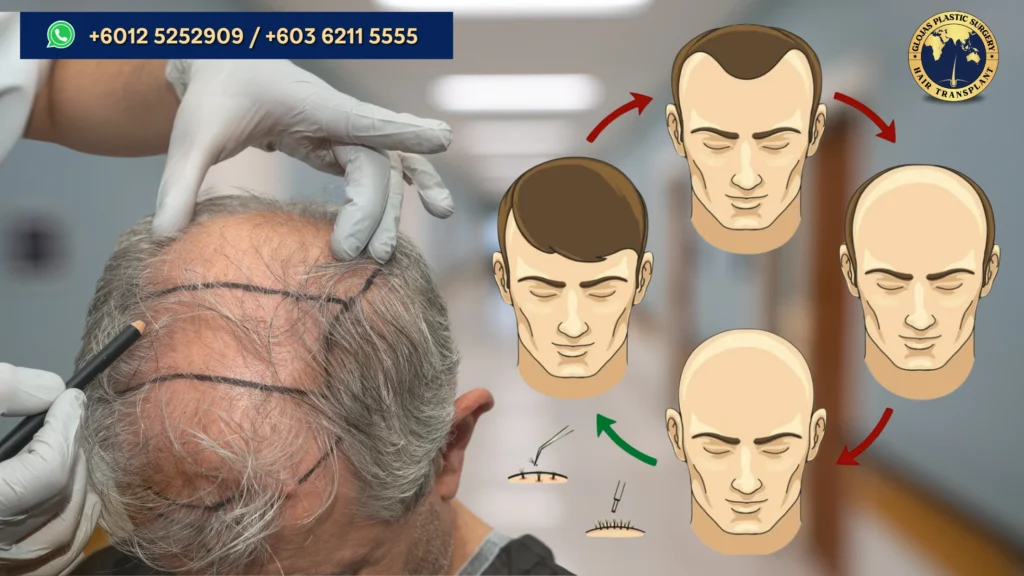
Hair loss is a common concern affecting millions of people worldwide. For those exploring hair restoration options, understanding the Norwood scale and the role of hair grafts is essential. This article delves into the relationship between the Norwood stages and hair grafts, offering a comprehensive guide to help you make informed decisions. What is the Norwood Scale? The Norwood scale, also known as the Hamilton-Norwood scale, is a classification system used to measure the extent of male pattern baldness. Developed by Dr. James Hamilton in the 1950s and later revised by Dr. O’Tar Norwood in the 1970s, this scale helps in assessing the severity of hair loss and planning appropriate treatment strategies. The Norwood Stages Stage 1: Minimal hair loss along the hairline. Stage 2: Noticeable recession of the hairline, typically around the temples. Stage 3: Deepening of the recession at the temples, with a more pronounced M-shape. Stage 4: Significant hair loss at the crown and a receding hairline that continues to move backward. Stage 5: A larger area of hair loss at the crown, with a band of hair separating the crown from the hairline becoming thinner. Stage 6: The bridge of hair separating the crown and the hairline is nearly gone, leading to a larger bald area. Stage 7: The most severe stage, with only a thin band of hair remaining on the sides and back of the scalp. Hair Grafts and the Norwood Stages Hair grafts are a critical component of hair transplant procedures. A hair graft typically contains 1-4 hair follicles and is transplanted from a donor area (usually the back or sides of the scalp) to the balding or thinning areas. How Norwood Stage Influences Hair Graft Needs The number of hair grafts required for a successful transplant depends on the Norwood stage of hair loss: Stage 1-2: Early stages of hair loss might require fewer grafts (500-1500) to fill in the receding hairline or small bald spots. Stage 3-4: Moderate hair loss stages might need 1500-3000 grafts to address both the hairline and crown areas. Stage 5-6: Advanced stages often require 3000-5000 grafts due to extensive bald areas at the crown and front. Stage 7: Severe hair loss might need 5000+ grafts, depending on the size of the balding area and the desired density. Planning Your Hair Transplant A thorough consultation with a qualified hair transplant surgeon is essential to determine the exact number of grafts needed. The surgeon will consider factors like the Norwood stage, hair type, donor hair availability, and desired outcome. Hair Transplant Techniques Two primary techniques are used for extracting hair grafts: Follicular Unit Transplantation (FUT): This method involves removing a strip of scalp from the donor area, dissecting it into individual grafts, and transplanting them. It is suitable for covering large areas but may leave a linear scar. Follicular Unit Extraction (FUE): Individual hair follicles are extracted directly from the donor area and transplanted. FUE is less invasive and leaves minimal scarring, making it a popular choice for many patients. Post-Transplant Care and Results Post-transplant care is crucial for ensuring the success and longevity of your hair grafts. Patients are typically advised to avoid strenuous activities, follow a prescribed medication regimen, and attend follow-up appointments. Results from hair grafts can vary, but most patients start to see new hair growth within 3-4 months post-surgery, with full results visible at around 12-18 months. Conclusion Understanding the Norwood stages and the role of hair grafts is vital for anyone considering hair restoration. By assessing your stage of hair loss and consulting with a qualified surgeon, you can develop a personalized treatment plan to achieve natural and lasting results. For more information on hair grafts and the Norwood scale, or to schedule a consultation, contact a reputable hair transplant clinic today. Embrace the journey to regain your confidence and achieve a fuller head of hair.